Internetwork Reliability Options
The level of application and network availability often is balanced against the cost of implementing the redundant/backup systems. It is not uncommon for the cost of making a network completely redundant or fault tolerant to be prohibitive. It is between this 100 percent network availability and the required availability (by the network applications) that the balance is determined.
Figure 19-4 illustrates a four-node nonredundant network design with two levels of hierarchy: Corporate HQ and three remote sites. There is no redundancy built into this network; if a site router fails, all users at that site have no network connectivity; if the Corporate HQ site fails, users at all remote sites have lost connectivity to corporate resources.
Figure 19-4. Four-Node Nonredundant Network
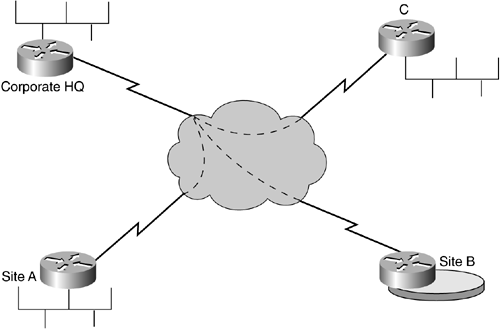
There are various approaches available to a network administrator/designer in creating a redundant internetwork, minimizing the impact a network-related outage has on network users. These approaches are as follows:
Redundant WAN Links
Meshed Network Topologies
Redundant Power Systems
Fault-Tolerant Media
Hardware Backup
Each of these approaches is discussed in the following sections.
Redundant WAN Links
Redundant WAN Links are considered to be the least reliable component in an internetwork, often because of local loop issues. This suspect reliability, coupled with the importance of WAN links interconnecting LANs, make WAN links good candidates for redundancy and backup implementations.
The customer site implements a second WAN access link, either to the same network service provider via a diverse path from the primary link or to another network service provider, also via a diverse path from the primary link. Routers can automatically adjust for failed WAN links based on the routing algorithms (protocols) used, such as EIGRP, OSPF, or BGP. If a WAN link fails, these routing protocols will recalculate and converge on the new network topology.
Meshed Network Topologies
A meshed network topology enables interconnectivity of every node on a network with every other node. In large networks, full-meshed topologies can be difficult to manage, with the number of connections determined by this formula: (N x (N-1)) / 2. For example, a network with 25 nodes yields 300 connections ((25 x 24)/2) = 300.
Meshed topologies often are more cost-efficient than redundant WAN links at every site. Consider the following three-node network (see Figure 19-5).
Figure 19-5. Three-Node Network
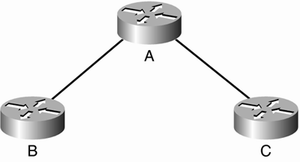
Presume that each WAN Link costs $1,000/month; therefore this network costs $2,000/month in WAN charges (A 

Figure 19-6. Three-Node Network with Redundant WAN Links

As an alternative to redundant WAN links at each site, a full-mesh WAN link topology can be used, as illustrated in Figure 19-7.
Figure 19-7. Three-Node Network with Full-Mesh WAN Links
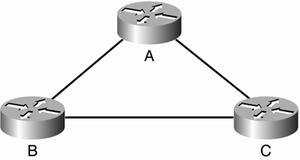
The cost for this network using the same $1,000/month model for WAN links totals $3,000/month versus the $4,000/month cost for the redundant links. The network routing protocols will detect the failure of a WAN link and will converge on the new topology and reroute traffic as appropriate.
The meshed topology (see Figure 19-7) has three advantages over a redundant star topology (see Figure 19-6). These advantages are as follows:
A meshed topology is often less expensive than the redundant star topology, at least by the cost of one WAN link.
A meshed topology provides more direct communication between WAN sites, which can translate into improved application availability.
A meshed topology enables distributed network operation, preventing network bottlenecks at the "root" or head-end of the network, often corporate headquarters.
Redundant star topologies, like the one illustrated previously in Figure 19-6, should be considered in either of the following situations:
Little traffic travels between remote WAN sites.
Traffic between the WAN head-end, often corporate office, and remote sites is delay-sensitive or mission critical. The additional WAN link (hop) might not be tolerable by such applications.
NOTEThe full-mesh topologies discussed here are physical links, such as WAN access. Logical network topologies, such as those created by Frame Relay or Asynchronous Transfer Node (ATM) Permanent Virtual Circuits (PVCs), can be considered more cost-efficient than both redundant star topologies and fully-meshed WAN links. There is no right or wrong way to provide redundant connectivity. The network administrator/designer must strike a balance between the organization's internetworking or communications needs and the cost incurred by the solution. |
Redundant Power Systems
Power failures can be common in large-scale enterprise networks and can be caused by a wide range of actions: tripped circuit breakers, dislodged power cords, lightning strikes, brown-outs, or local power company failures. Because power failures are difficult to predict and preempt, each organization must assess their power needs, the probability of each type of power failure, and the impact of such a failure.
Large organizations can negotiate with their local power company for feeds from multiple power grids, similar to dual-access to a network service provider's WAN (see Figure 19-8).
Figure 19-8. Dual Power Feeds
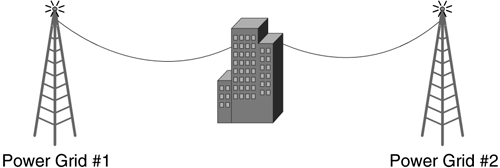
Dual power feeds from the power company are not always available, and they can be cost-prohibitive. In these instances, an organization can install generators, as illustrated in Figure 19-9, to provide power to an entire facility or to mission-critical systems only.
Figure 19-9. Generator Backup
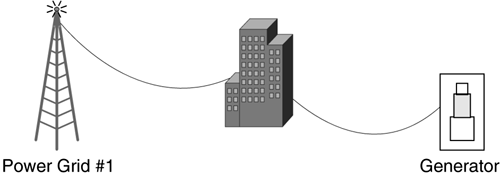
Another option for larger organizations is the deployment of Uninterrupted Power Supplies (UPS) to provide power to mission-critical equipment such as server farms and WAN networking equipment (see Figure 19-10).
Figure 19-10. UPS

UPS systems run on charged batteries and, depending on the UPS deployed, the time that power is available can be measured in hours or minutes. UPS was developed to provide end-users with enough time to perform a graceful shutdown of their workstations in the event of a power outage, preventing corrupted data hard drives. More sophisticated UPS systems can provide power for a considerably longer period of time, but as with all things, this additional time comes with a financial cost that must be considered.
Fault-Tolerant Media
Media failure describes outages attributed to the media and its connections with network hardware. Some examples of media failure are network interface card (NIC) failures, attachment unit interface (AUI) cable failures, or LAN hub and transceiver failures.
A media failure often is the result of operator error and cannot always be easily eliminated. The impact of media failure on a network can be mitigated in one of two ways:
Divide the network segment into smaller pieces, minimizing the effect of a network segment failure.
Attach each LAN host to two different media segments via dual-NICs to a dual media backbone, such as Fiber Distributed Data Interface (FDDI) or dual-Ethernet segments. This approach can double the cost of a network implementation and should be considered only for mission-critical hosts.
Hardware Backup
The use of dual networking hardware devices, such as routers, switches, hubs, and bridges, can reduce the effect of a hardware failure on a network. If one of these devices fails, network discovery protocols can help the end-user workstations choose a new path to the internetwork. For example, in an environment with a primary and backup router, routing metrics can be used to ensure that the backup router is used only in the event the primary router fails.
Cisco Note: HSRPCisco's Hot Standby Routing Protocol (HSRP) provides automatic router backup when configured on Cisco routers running IP over Ethernet, FDDI, and Token Ring LANs. HSRP is compatible with Novell's Internetwork Packet Exchange (IPX), AppleTalk, and Banyan VINES, and is compatible with DECnet and Xerox Network Systems (XNS) in certain configurations. HSRP allows changes in network topology to be transparent to network hosts, often taking no more than 10 seconds to converge on a topology change. For Internet Protocol (IP), HSRP enables one router to automatically assume the function of the second router if the second router fails. This is particularly useful when the users on one subnet require continuous access to resources in the network. |
EAN: 2147483647
Pages: 269
- Chapter II Information Search on the Internet: A Causal Model
- Chapter III Two Models of Online Patronage: Why Do Consumers Shop on the Internet?
- Chapter VI Web Site Quality and Usability in E-Commerce
- Chapter VIII Personalization Systems and Their Deployment as Web Site Interface Design Decisions
- Chapter XVI Turning Web Surfers into Loyal Customers: Cognitive Lock-In Through Interface Design and Web Site Usability